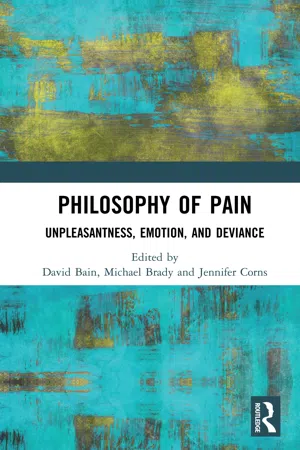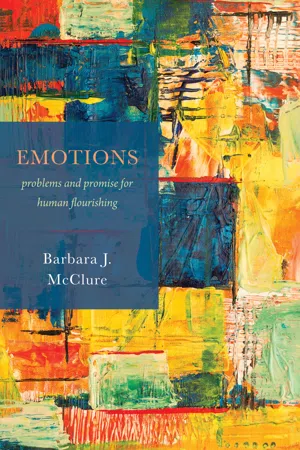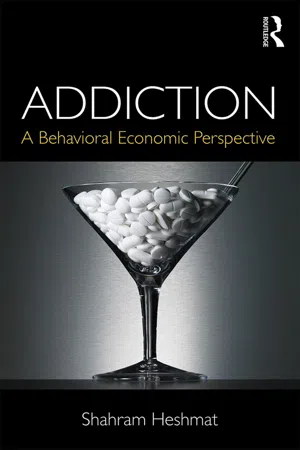Psychology
Negative Emotions
Negative emotions refer to feelings such as anger, sadness, fear, and disgust. These emotions are typically unpleasant and can have a detrimental impact on an individual's well-being and mental health. In psychology, understanding and managing negative emotions is important for promoting emotional resilience and overall psychological well-being.
Written by Perlego with AI-assistance
Related key terms
6 Key excerpts on "Negative Emotions"
- eBook - ePub
Philosophy of Pain
Unpleasantness, Emotion, and Deviance
- David Bain, Michael Brady, Jennifer Corns(Authors)
- 2018(Publication Date)
- Routledge(Publisher)
something must account for such a classification. Most suggest that each emotion contains something that makes it positive or negative. That “something” is not itself an emotion. Rather, it is a component part that can occur in different emotions, and perhaps too in mental states that we would not classify as emotions. For example, hunger is not an emotion, but, like Negative Emotions, it seems to have negative valence. Conversely, sexual arousal may not be an emotion, but it has positive valence. Valence, then – negative valence in particular – could be a component of pain. This would explain why pain negativity is like emotional negativity without supposing that pain negativity is itself an emotion.To flesh out this account, we need a theory of valence. A number of theories can be found in the literature. Here I will offer a quick review, focusing on negative valence, and then I will introduce the theory I favor. For a more detailed discussion, see Prinz (2004: chap. 7). According to one account, valence is a feeling. Negative Emotions feel bad. Though highly intuitive, I think the feeling account won’t work. Notice that different negative feelings feel bad in different ways: the sickening revulsion that attends disgust differs from the heart pounding, respiratory unrest of fear. To say that these emotions feel bad is to say that we dislike these specific feelings; there is no phenomenal common denominator that unites them. Indeed, under some contexts, the very same feelings might be welcome: fear on a roller coaster or disgust during a graphic horror movie. Rather than equating valence with a feeling, we would do better to explain what happens when a variety of different feelings are taken as bad.A second theory of valence focuses on behavior. In particular, Negative Emotions are associated with withdrawal behaviors and positive emotions associated with approach behaviors. This suggestion is more promising than the feeling theory. We can say, for example, that fear and disgust both motivate us to withdraw from their causes, even if they feel different. We can also say that fear loses its negative valence in those accessions when it is not accompanied by a withdrawal motivation: as with fear on a roller coaster for those who enjoy such experiences. Trouble for the view arises, however, when we consider other cases. Anger, for instance, is widely recognized as negatively valenced, but it is associated with an approach behavior, namely aggression (Carver and Harmon-Jones, 2009). With sadness, too, there is often a desire to approach those who might offer comfort, as when a child cries out for a caregiver. Even fear can trigger a fight response when a person is cornered. So there is no systematic relationship between negativity and withdrawal. - eBook - ePub
The Emotional Learner
Understanding Emotions, Learners and Achievement
- Marc Smith(Author)
- 2017(Publication Date)
- Routledge(Publisher)
We began this chapter with a simple hypothesis: positive emotions lead to higher levels of academic achievement. What started out as a fairly straightforward suggestion proved to be more complicated than anticipated because the idea of positive and Negative Emotions being separate from each other turned out to be an unhelpful distinction. Emotions are more accurately described as affective states and the dichotomy of positive and Negative Emotions turns out to be false when we take the evidence into account. Positive Psychology was certainly founded upon laudable principles, but its foundations are weak and unable to support many of its ideas. When we delve deep enough we discover a highly complex yet fascinating situation where positive emotions sometimes hinder and negative ones often help, amounting to a direct attack on the view that happier learners are more successful. We do, however, need to stress the view that severe Negative Emotions such as chronic anxiety and depression do negatively impact on both wellbeing and academic achievement (and while I do discuss these in more detail later, the impact of severe psychological problems is beyond the limitations of this book). Emotions, as I have already stated, are slippery characters and should be treated with a degree of respect; negative mood is not a bad thing but when an individual spends the majority of their time in this state then problems can ensue – I’m not advocating that teachers should induce negative states just to raise levels of achievement, but neither should teachers fall into the trap that all positive emotions are useful in all circumstances.p.66The theory proposed by Pekrun is perhaps the most useful for our purpose (Pekrun et al ., 2007). Learning is without doubt influenced by emotions just as all human behaviour is influenced by our emotional states. These states fluctuate wildly and are involved in an intricate interplay of biology and environment that will impact on the pupils in a classroom in highly diverse ways. Furthermore, the complex brain and self-building during the teenage years can make these emotional states more volatile, but this isn’t inevitable, so teenagers deserve special consideration (see Chapter 9 - eBook - ePub
The Dark Side of Organizational Behavior
Examining Undesirable Aspects of Organizational Life
- H. Cenk Sözen, H. Nejat Basım, H. Cenk Sözen, H. Nejat Basım(Authors)
- 2022(Publication Date)
- Routledge(Publisher)
Figure 1.1 shows the categorization by Shaver et al. (1987), which is a comprehensive grouping of both primary and secondary emotions and also used by Weiss and Cropanzano (1996) in developing AET (Cropanzano, Dasborough and Weiss, 2017). This chapter focuses only on Negative Emotions at organizations.Antecedents and consequences of Negative Emotions at workFigure1.1Antecedents and consequences of Negative Emotions
What are the major causes of Negative Emotions at work? Are there direct relations between certain events and Negative Emotions? Does every negative event result in the same negative emotion every time? Do all individuals go through the same experience when they have Negative Emotions? And what are the results of Negative Emotions felt by organizational members?Organizations are complex and abstract entities, and therefore, have certain implicit as well as explicit aspects and processes within their boundaries. Oftentimes, causes and effects of Negative Emotions are not obvious or easy to anticipate in such complicated environments. In this section, we will discuss and categorize the broad range of antecedents and consequences of Negative Emotions.Antecedents (causal events) of Negative Emotions
Emotions do not occur in isolation; they always have some context (Domagalski, 1999), and there will often be a negative or negatively perceived event, object or person-triggering emotions. The expression of Negative Emotions is a common and natural reaction to negative events experienced at work (Tiedens, 2001). As there may be a variety of causes anteceding Negative Emotions, we will categorize such antecedents as individual-, organization-, work- and other-related for the sake of simplicity. There may be a larger number of causal antecedents in each category, we will however be discussing only a few common examples to clarify the context of each category. - eBook - ePub
Emotions
Problems and Promise for Human Flourishing
- Barbara J. McClure(Author)
- 2019(Publication Date)
- Baylor University Press(Publisher)
6Emotions as Psychological Constructions in Context
Recent Neuroscientific Discoveries
Introduction
Human beings experience emotion as a central and often defining aspect of their lives. Every day, at least in North America, people ask and answer the question “how does that make you feel?” over coffee or in a therapist’s office: it is assumed that experiencing and exploring an emotion gives one access to something inevitable, inside, real and true in some way. But this is only partly correct: emotions are not something a person “has” inside.1 Nor are particular emotions inevitable in the ways we often take them to be. As chapter 5 demonstrated, emotions are neither physiologically automatic nor necessarily predictable in their origin, expression, or in people’s experience of them: recent structural theories of emotions that predicted particular emotions would arise in specific sociocultural-political contexts do not always bear out. This is, in part, because researchers’ starting assumptions were not correct.The dominant paradigm in studies of emotions has assumed that emotions are entities that exist in particular parts of the brain (e.g., Paul MacLean and the limbic system) or in the “deep structure of the situation” (e.g., Theodore Kemper’s social hierarchies) that are just waiting to be “triggered” by a particular event.2 Until recently, the most prominent scientists assumed that each different subjective experience is the result of separate and distinct “emotional” locations and processes in the brain—for example, those related to emotion, cognition, memory, and perception. In fact, neuroscientists have been trying to map these faculties to specific locations in the brain for more than a century.3 The research programs that followed this thinking assumed that emotions are discrete, basic categories of physiological and psychological phenomena; basic emotions such as fear, anger, happiness, sadness, and so on are discrete expressions of particular emotions, irreducible and universal;4 that the discrete emotion types are localized in distinct areas of the brain, whether these are single brain regions or discrete networks; and that specific emotions are communicated bodily in particular ways and result in predictable behaviors.5 Early studies of emotions—which led to general assumptions about emotions that continue to prevail—suggested that people experience emotions because people “have” emotions inside them that arise given the right circumstances. This model assumes there are predictable physiological systems that are activated and predictable emotions that are “triggered,” resulting in subsequent and predictable experiences of feeling. These beliefs have a long history: seventeenth-century philosopher Rene Descartes believed that emotions emerge from the pineal gland (a small gland in the middle of the brain), while physiologist Walter Cannon argued that the thalamus is the neural center for emotion.6 As noted in previous chapters, both James Papez and Paul MacLean argued that emotions emerge from the limbic system, as a set of phylogenetically “old” subcortical and allocortical structures.7 - eBook - ePub
The Emotions
A Philosophical Introduction
- Julien Deonna, Fabrice Teroni(Authors)
- 2012(Publication Date)
- Routledge(Publisher)
2 The diversity and unity of emotions
In the previous chapter, we highlighted the diversity of the affective domain by drawing attention to some important differences between the emotions and other affective phenomena. In the present chapter, we turn to an examination of the diversity within the category of emotion. We shall inquire whether there are important differences amongst the phenomena that we call emotions, and, if so, whether this casts doubts on the fundamental unity of this category. To do so, we have to examine more closely some of the important distinctions that can be made within the narrower domain of emotions. We shall start by considering some distinctions, primarily those between positive and Negative Emotions and between conscious and unconscious emotions, contrasts within the domain that in our opinion do not threaten the unity of the category as a whole. Next, we shall turn our attention to another distinction, that between basic and nonbasic emotions, which structures many current debates about the emotions. Since it has been argued that this distinction puts into question the unity and theoretical interest of the common-sense category of emotion, our discussion culminates with an evaluation of this suggestion.Positive and Negative Emotions
A first distinction that structures our intuitive grasp of the emotional domain is that between positive and Negative Emotions. Intuitively, sadness, fear, disgust, shame, and regret count as negative, while joy, admiration, pride, and amusement count as positive. In this context philosophers and psychologists speak of the ‘polarity’ or ‘valence’ of emotions. Accounting for this central aspect of emotional phenomena has typically taken one of two forms: we may approach valence in hedonic or in conative terms.The hedonic approach has it that the various kinds of emotions are to be classed as positive or negative in virtue of ‘what it is like’ to experience them. The idea here, one that already surfaced in our brief discussion of the phenomenology of the emotions in Chapter 1 , is that each kind of emotion is among other things essentially a kind of pleasure or displeasure, pleasure and displeasure being considered as irreducible, phenomenological qualities (hence the talk in terms of the positive or negative hedonic quality of an emotion). This is perfectly compatible with the idea that certain kinds of emotions are hedonically ambivalent (e.g., nostalgia and scorn). A strong version of this view would then consist in claiming that each emotion-type - eBook - ePub
Addiction
A Behavioral Economic Perspective
- Shahram Heshmat(Author)
- 2015(Publication Date)
- Routledge(Publisher)
Each emotion has a certain feel. An angry person feels a kind of warmth and agitation; it is directed usually at another person or is the result of a slight or offense. A person who is disgusted feels a kind of nausea; it is directed at the object that provokes the disgust. Fear is identified with a chilled and queasy feeling. The feeling of a “warm glow” accompanies donations to charity. Summary This section outlines several components of emotion. Together, these components comprise the experiential content of the emotion. The experiential content of an emotion reflects how emotions are felt and what emotions mean to the person experiencing them. Thus, for a full understanding of emotions, we should not look at changes in a single emotion component, but rather at patterns of changes across several components. The knowledge about the experiential content of an emotion helps to understand the motivations that arise during this experience, and allows us to make specific behavioral predictions. For example, the experience of anger in individuals goes with feelings like exploding, thoughts of unfairness, and tendencies to behave aggressively, and with a motivation to retaliate. Guilt is seen as one of the moral emotions that are linked to the interests of other people and that motivate prosocial behavior. Types of Emotions Emotions can be classified as primary and complex. There are at least eight primary or basic emotions—interest, joy, distress, anger, fear, anxiety, surprise, disgust—associated with a single facial expression (Plutchik, 2003). Primary emotions are universal and innate. We all tend to think this as we express “people everywhere are essentially the same.” We inherit the capacity to have these basic emotions. A smile is recognized in all cultures as a signal of happiness and social welcome, and weeping is a signal of sadness. The basic emotions can be characterized by a number of features that are immediately observable
Learn about this page
Index pages curate the most relevant extracts from our library of academic textbooks. They’ve been created using an in-house natural language model (NLM), each adding context and meaning to key research topics.





